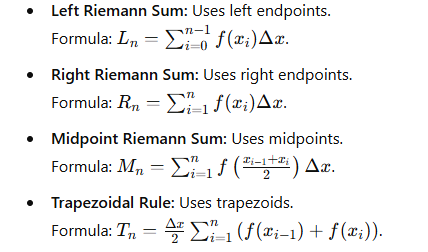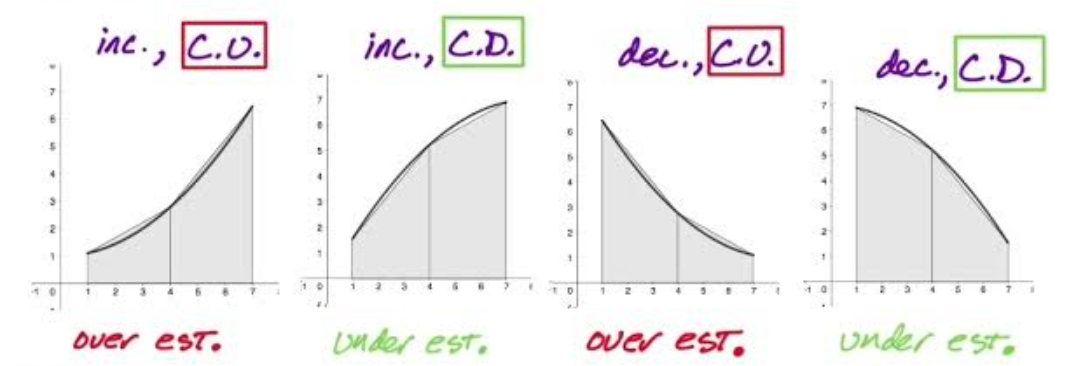AP Calculus BC Review
1/83
There's no tags or description
Looks like no tags are added yet.
Name | Mastery | Learn | Test | Matching | Spaced |
|---|
No study sessions yet.
84 Terms
horizontal asymptote
limit as x approaches infinity equals a constant 'a', y=a.
vertical asymptote
limit as x approaches 'b' equals infinity, x=b
Continuity Conditions
lim x→c f(x) exists, f(c) exists, and lim x→c f(x) = f(c)
Jump Discontinuity
lim x→c f(x) DNE
Hole/Removable Discontinuity
lim x→c f(x) ≠ f(c)
Infinite Discontinuity
f(c) DNE
Intermediate Value Theorem
if f is continuous on [a, b] and K is a number between f(a) and f(b), then there exists c in [a, b] such that f(c) = K.
Squeeze Theorem
If h(x) <= f(x) <= g(x) for all x near c, and lim x→c h(x) = lim x→c g(x) = L, then lim x→c f(x) = L
Instantaneous Rate of Change
tangent line
f’(x) = lim h→0 [f(x+h)-f(x)/h]
or, at a point c:
f’(c) = lim x→c [f(x)-f(c)/x-c]
Average Rate of Change
secant line
f(b) -f(a)/b-a
Non-differentiable points
Cusp, sharp turn, vertical tangent.
Derivative of ax
(ln|a|)ax
Derivative of logax
1/x*ln|a|
Chain Rule
f'(g(x)) * g'(x)
Equation of a Tangent Line
y - f(c) = f’(c)(x-c)
Derivative of an Inverse Function
d/dx[f-1(x)] = 1/f’(f-1(x))
Speed
|v(t)|
Interpretation of Sign of Velocity Function
v = 0 → particle at rest
v > 0 → moving right/up
v < 0 → moving left/down
Interpretation of Sign of Acceleration Function
a = 0 → constant velocity
a > 0 → accelerating to the right/up
a < 0 → accelerating to the left/down
speeding up
v(t) and a(t) are same sign
slowing down
v(t) and a(t) are opposite signs
1st Derivative Test
1) find critical points (f’(x) = 0)
2) make sign chart
3) if f’(x) changes from + to -, f(x) has a relative max.; if f’(x) changes from - to +, f(x) has a rel. min.; if it doesn’t change, neither
2nd Derivative Test
1) find critical points (f’(x) = 0)
2) if f’’(c) < 0, concave down; f(c) is a rel. max.; if f’’(c) > 0, concave up; f(c) is a rel. min; if f’’(c) = 0, test is inconclusive.
If f' is positive, f(x) is
Increasing
If f' is negative, f(x) is
decreasing
If f'' is positive, f(x) is
concave up
If f’’ is negative, f(x) is
concave down
Point of Inflection
f’’(x) = 0 AND f’’(x) changes sign
Relative Maximium/Minimum
critical point where f’(x) changes sign
EVT
if f(x) is cont. on [a,b], then f(x) has a max and min on the interval
MVT
if f(x) is cont. on [a,b] and differentiable on (a,b), then there exists a number c on the interval such that: f'(c)= (f(b)-f(a))/(b-a)
IROC = AROC
slope of tangent line = slope of secant line
Finding Absolute Extrema
1) Find critical points
2) Plug in critical points into original function
3) Plug in endpoints of interval into original functoin
4) highest y-value → max, lowest y-value → min
Fundamental Theorem of Calculus (FTC)

tan-1(x) special integral formula
1/a arctan(x/a) + C
(a is a constant)
IBP Formula
int(udv) = uv - int(vdu)
Order for IBP Selection
Log
Inverse Trig
Algebraic
Trig
Exponential
Riemann Sum Formulas

Rectangular Riemann Sum Approximation Errors

Trapezoidal Riemann Sum Approximation Error
If the function is concave up, the Riemann sum will be an overestimate. If the function is concave down, the Riemann sum will be an understand.

Midpoint Riemann Sum Approximation Error
If the function is concave up, the midpoint Riemann sum will be an underestimate. If the function is concave down, the midpoint Riemann sum will be an overestimate
(opposite of trapezoid)
Exponential Growth/Decay
dy/dt = ky → y = Cekt
Logistic Growth
dy/dt = ky(1 - y/L) → y = L/1+be-kt (look juan (1) be a kitty (k-t))
L = carrying capacity
inflection point at L/2, growth rate is max. at this value
Euler's Method
initial: (x0, y0)
h: value of each step (total distance/# of steps)
F(x,y): differential equation (may be off a diff. form)
xn = xn-1 + h
yn = yn-1 + h*(F(xn-1, yn-1))
Avergge Value of a Function
1/b-a * int(a, b, f(x))
Area Between Two Curves
int(a, b, f(x) - g(x)) where f(x) is upper function
int(a, b, f(y) - g(y)) where f(y) is right-most function
Average Veolcotiy
1/b-a * int(a, b, v(t))
Total Distance Traveled
int(a, b, |v(t)|)
Displacement (from a point)
s(0) + int(a, b, v(t))
Volume (Cross-Sections)
int(a, b, Area)
base of shape sitting perp. to x-axis (top-bottom) or y-axis (right-left)
Disc Method
V = π * int(a, b, [f(x)]²)
over a line: π * int(a, b, [f(x) - k]²)
Washer Method
V = π * int(a, b, [[f(x)]²-[g(x)]²]]) where f(x) is outer function
over a line: π * int(a, b, [[f(x)-k]²-[g(x)-k]²]])
Arc Length of a Curve
int(a, b, sqrt(1 + [f’(x)]²))
Parametric Derivatives
dy/dx = (dy/dt) / (dx/dt)
d²y/dx² = d/dt(dy/dx)/dx/dt
Parametric Tangents
horizontal tangent: dy/dt = 0
vertical tangent: dx/dt = 0
Arc Length of a Parametric Curve
int(a, b, sqrt([dx/dt]²+[dy/dt]²))
Speed (Vector)
sqrt([dx/dt]²+[dy/dt]²)
same as arc length (without the integral)
Distance Traveled (of a vector)
int(a, b, sqrt([dx/dt]²+[dy/dt]²))
same as arc length/speed
Vector Position Formula
x(t2) = x(t1) + int(t1, t2, dx/dt)
y(t2) = y(t1) + int(t1 + t2, dy/dt)
Derivative of a Polar Function
dy/dx = f’(θ)sinθ + f(θ)cosθ / f’(θ)cosθ - f’(θ)sinθ
Polar Conversions
(x,y) → (r,θ)
r = sqrt(x² + y²)
tan-1(y/x) = θ
(r, θ) → (x,y)
x = rcosθ
y = rsinθ
Area of a Polar Curve (Singular)
½ * int(a, b, r2dθ)
Area Between Two Polar Curves
½ * int(a, b, [[f(θ)]² - [g(θ)]²]); where f(θ) is outer polar curve
Arc Length (Polar Curve)
int(a, b, sqrt(r²+(dr/dθ)²))
nth term test
if lim n→ ∞ an ≠ 0, series diverges
CONVERSE IS NOT NECESSARILY TRUE
Geometric series
Σa1(r)n-1
if |r| < 1, converges
if |r| ≥ 1, diverges
Sum of a Convergent Geometric Series
a1 / 1 - r
p-series
Σan = Σ1/np
if p > 1: converges
if p ≤ 1: diverges
Direct Comparison Test
if an ≤ bn OR an > bn for all n,
if one converges/diverges, so does the other.
Limit Comparison Test
if lim n → ∞ [an/bn] = finite/positive (L ≠ 0 or ±∞):
an and bn either both converge or diverge.
Alternating Series Test
if lim n→∞ an = 0 AND an is decreasing, series is convergent.
Alternating Series Estimation Theorem
|Rn| = |S - Sn| ≤ bn+1
Remainder (error) of estimation using a finite partial sum is no greater than value of following term.
Integral Test
if f(x) is cont., positive, and decreasing:
if int(f(x)) converges, series converges; if int(f(x)) diverges, series diverges.
Ratio Test
lim n→∞ |an+1 / an| = L
if L < 1: converges
if L > 1: diverges
if L = 1: inconclusive
Telescoping Series
1/n(n+1); a series where most terms cancel each other out, leading to a simple sum of the remaining terms (convergent)
Harmonic Series
1/n; divergent
Absolute Convergence
A series is said to converge absolutely if the series of its absolute values converges. This implies that the original series also converges.
Conditional Convergence
A series converges conditionally if it converges, but its series of absolute values diverges. This means that the convergence of the series relies on the specific arrangement of its terms.
Taylor Polynomial
f(c)+ f'(c)(x-c) + f’’(c)(x-c)^2/2! + f'''(c)(x-c)^3/3! + …
Maclaurin Polynomial
f(0)+ f'(0)(x) + f’’(0)(x)^2/2! + f'''(0)(x)^3/3! + …
Finding Interval of Convergence
1) Use Ratio test to determine values of x that makes the series converge (lim n→ ∞ |an+1/an|) < 1)
2) check endpoints by plugging into original function (plug in for x; if series converges, inclusive; if series diverges, exclusive)
1/1+x Power Series

ex Power Series

sin x Power Series

cos x Power Series
